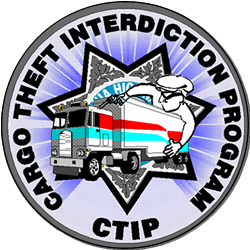Background

In January of 1994, Assembly Bill 813 was passed which provided funding to implement and maintain ongoing statewide cargo theft suppression efforts. The Cargo Theft Interdiction Program (CTIP) was created to combat the ever increasing cargo theft problem. Over the past decade the cost of cargo theft related crimes has risen dramatically. It is estimated that combined losses suffered by the trucking industry, insurance companies, and the railroads, surpasses $10 BILLION in the United States annually. However, no financial total can adequately quantify the actual costs of cargo theft related losses which includes jobsite downtime, replacement of stolen commercial vehicles, time spent on additional paperwork, and increased insurance costs.
Prior to 1994, in the State of California, no proactive enforcement specifically directed at cargo theft related crimes existed. Consequently, the criminal element determined that the level of profit derived from the theft of cargo loads far surpassed the risk of apprehension. What quickly became apparent to several unethical entrepreneurs was that profits derived from the theft and sale of cargoes were substantial and tax free. Thefts of sought after commodities such as televisions, camcorders, and computers, could reach a profit margin as high as 80 cents on the dollar. For example, an organized theft group with several reliable buyers, which stole a load of computers valued at $1 million, conceivably could earn as much as $800,000 from the sale of the stolen commodity.
In response to concerns from the California Trucking Association (CTA) over this rising problem, Assembly Bill 1683 was enacted. This legislation created funding for the enhancement of cargo theft enforcement statewide, and designated the California Highway Patrol (CHP) to coordinate and implement the program.
Statewide Problem Analysis
It is known, that on a regional level, the incidence of cargo theft is increasing. However, the overall scope of the problem statewide and the specific regions where cargo theft related crime is the greatest have been difficult to accurately determine. This is due to the nature of the commodity that is being stolen, (it is handled by many parties during transportation and distribution) and the inconsistent reporting procedures utilized by both the public and private sectors. To ensure the limited resources that are available for implementation of this program are utilized in the most efficient way, the CHP gathered detailed information concerning the rate, type and value of cargo being stolen statewide.
In California three regions were identified statistically as suffering the most significant impact from cargo theft related crime. They include Los Angeles / Inland Empire, the San Francisco Bay Area, and San Diego. Each of the identified regions is a complex distribution center with major harbors, airports, and rail systems, handling millions of cargo containers and commodities annually. Additionally, within each of the identified regions exists thousands of commercial businesses that ship and receive billions of dollars of merchandise routinely by way of major freeway networks.
With the growing number of cargo thefts statewide, an alliance has been established between law enforcement and private industry to maintain open lines of communication. Organizations such as the Western States Cargo Theft Association, American Trucking Association, CTA and National Cargo and Security Council Transportation company security directors and law enforcement personnel, meet on a monthly basis to discuss recent trends, losses, suspects, and active investigations. This type of partnership is the foundation of successful cargo theft enforcement.
Theft Trends
Armed Robberies
In Southern California, cargo thefts by way of armed hijackings and/or terminal robberies have increased during the last five years. Common trends involving cargo theft armed robberies include the following:
-
Terminal Robberies - organized theft groups enter a trucking facility, hold the security guard(s) and or employees hostage, and proceed to steal one or several loaded vehicles.
-
Hijackings - generally occur when a truck driver comes to a stop, be it at a signal light, truck stop, or dinner break. Theft groups will actually surveil the targeted commercial rig after receiving inside information regarding the transported load. Once the driver stops his rig, one or several gunman will enter the cab, detain the driver, and transport the load to a pre-determined destination. Eventually the driver is set free some distance from the theft location. Note: a percentage of hijackings are staged and involve the drivers.
Burglaries
Burglaries often occur at transportation truck yards, commercial parks, and railroad yards. Commonly, theft groups will enter the targeted facility, post look-outs, and spend several hours opening trailers and containers searching for a desirable commodity to steal. These crimes most often occur during the hours of darkness and or during the weekend. Common burglary tools include bolt cutters, tin snips, pliers, screwdrivers, flashlights, and filed down ignition keys.
Additional Trends
-
Driver Giveaways - where a driver actually participates in the conspiracy to steal a loaded rig. Drivers generally agree to turn over their rig to a theft group for a substantial cash payment.
-
Employee Involvement - occurs when a company employee, who has advanced knowledge of a specific trailer or container's load, provides cargo and transportation information to a theft group in preparation for theft.
-
Counterfeit Paperwork - generally used by independent drivers who transport chassis/containers from container terminals. Drivers present counterfeit paperwork to the security guards and ultimately make off with valuable loads.
-
Grab and Runs - often used by theft groups targeting trucks loaded with high-tech equipment. Crooks, traveling in family type vans, follow a targeted truck and once the rig stops, several suspects exit the van, open the trailer doors, and off-load as much property as they can before the rig proceeds.
-
Warehousing Stolen Cargoes - often times stolen rigs are transported to a pre-designated storage facility for off-loading and storage of stolen commodities. Warehouses include, but are not limited to, industrial storage facilities, public storage facilities, restaurants, pallet yards, single-family houses, apartments, and condemned buildings.
Cargo Theft / Organized Crime
Cargo theft is, in essence, a form of organized crime and in many cases violates Federal Statutes. The following is a list of applicable Federal Law that directly relates to Cargo Theft and Racketeering:
- Title 18 U.S. Code, Section 659: Theft from interstate shipments, UPS, Federal Express, Airborne Express, Etc.
- Title 18 U.S. Code, Section 1951: Interference with commerce by threat or violence.
- Title 18 U.S. Code, Section 1952: Interstate and foreign travel or transportation in aid of racketeering.
- Title 18 U.S. Code, Section 1957: Engaging in monetary transactions in property derived from specified unlawful activity (Cash value greater than $10,000).
Chapter 96: Racketeer Influenced and Corrupt Organizations
-
Title 18 U.S. Code, Section 1961 (1): definition of racketeering activity, to include any act or threat involving murder, kidnapping, gambling, arson, robbery, etc.
-
Title 18 U.S. Code, Section 2117: The breaking and entering of a carrier facility, as well as breaking the seals of railcars, commercial trailers.
-
Title 18 U.S. Code, Section 2314: Interstate transportation of stolen property of a value of $5,000 or more.
-
Federal carjacking statutes
